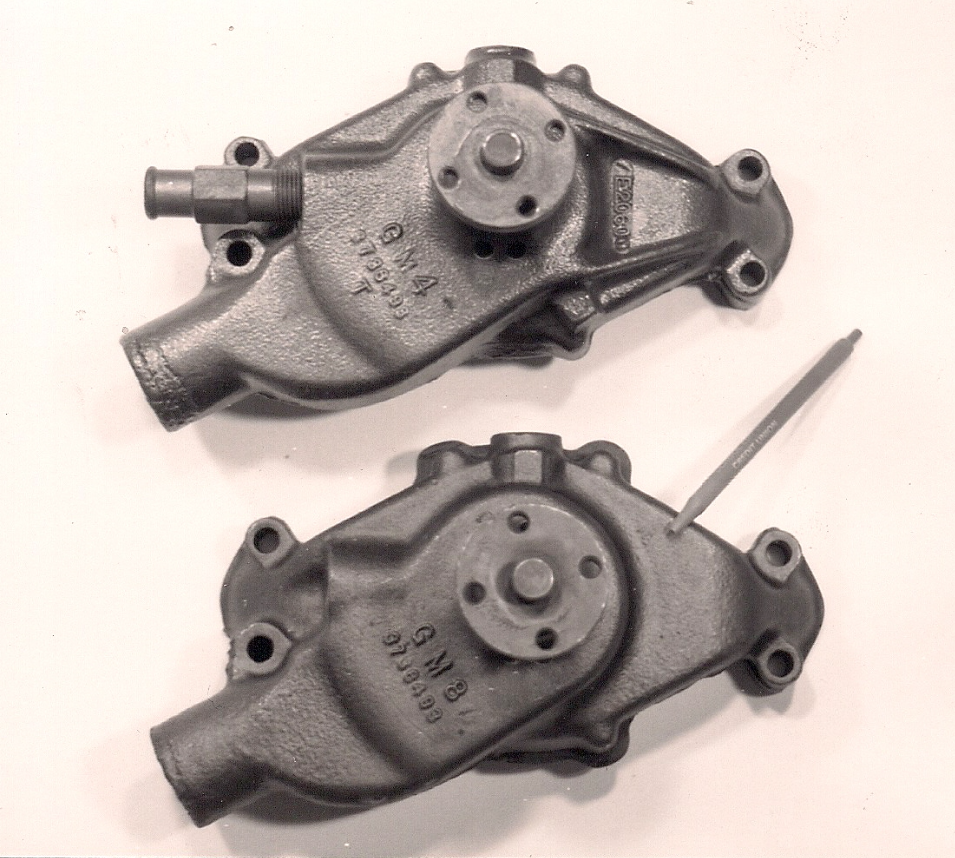Author: Alan L. Colvin
The standard Chevrolet waterpump is simply a cast iron pulley-driven pump, which is bolted to the front of a Chevrolet engine. This pump serves the function of forcing water and coolant through the engine, primarily the block, to cool the engine. As simple as this may sound, complications can arise when someone wants to restore their car and they want an original waterpump casting number and corresponding dates to match their engine.
In this edition of Chevy Classics, we are pleased to present updated information to an earlier (August 1992) article on Chevrolet waterpumps that ran in another national publication. As we requested in that article, several readers called and sent letters concerning new waterpump information. These responses resulted in a review of the documentation that was used to prepare that article. After several phone calls to our sources inside General Motors, we began to see a different pattern of information developing. Bill Mock of Bartlesville, Oklahoma, who has been supplying original waterpumps to the Corvette restoration industry for many years, was also contacted to help us piece the information together. The new General Motors information that we acquired was then cross-referenced into Bill Mock's application index. Bill has been compiling this index for the last twenty years. By utilizing these two sources, we feel confident that we now have the casting information correct.
There is great difficulty in assigning the absolute correct applications of water pumps installed on Corvettes from 1955 through 1982. One reason lies simply in the great variety of water pump configurations used. A second reason is that water pumps with the same design were often produced concurrently by different manufacturers, but with different casting numbers. The last and most puzzling piece of the applications puzzle is due to water pump rebuilders who altered original design features to enable a manufacturer to use a water pump on additional applications. On top of all this, water pumps are an often-replaced part. The water pump on any particular engine is as likely as not to be a replacement part, so you can see how the problem of researching and validating original casting numbers to specific models and years is very difficult. It should be noted that original 1955-60 water pumps had a flat plate on the backside of the pump, which was secured by six slotted pan-head screws.
There were two distinct water pump designs used on Chevrolet passenger cars and Corvettes between 1955-1959, the first from Flint, Michigan, and the second from Tonawanda, New York. From a restoration viewpoint, you should know that Flint engines were supplied with Flint water pumps and Tonawanda engines with Tonawanda pumps. The design differences between the two pumps are very easy to spot and can be a good indicator of an incorrectly restored engine. Corvette engines always used the Flint assembled waterpump.

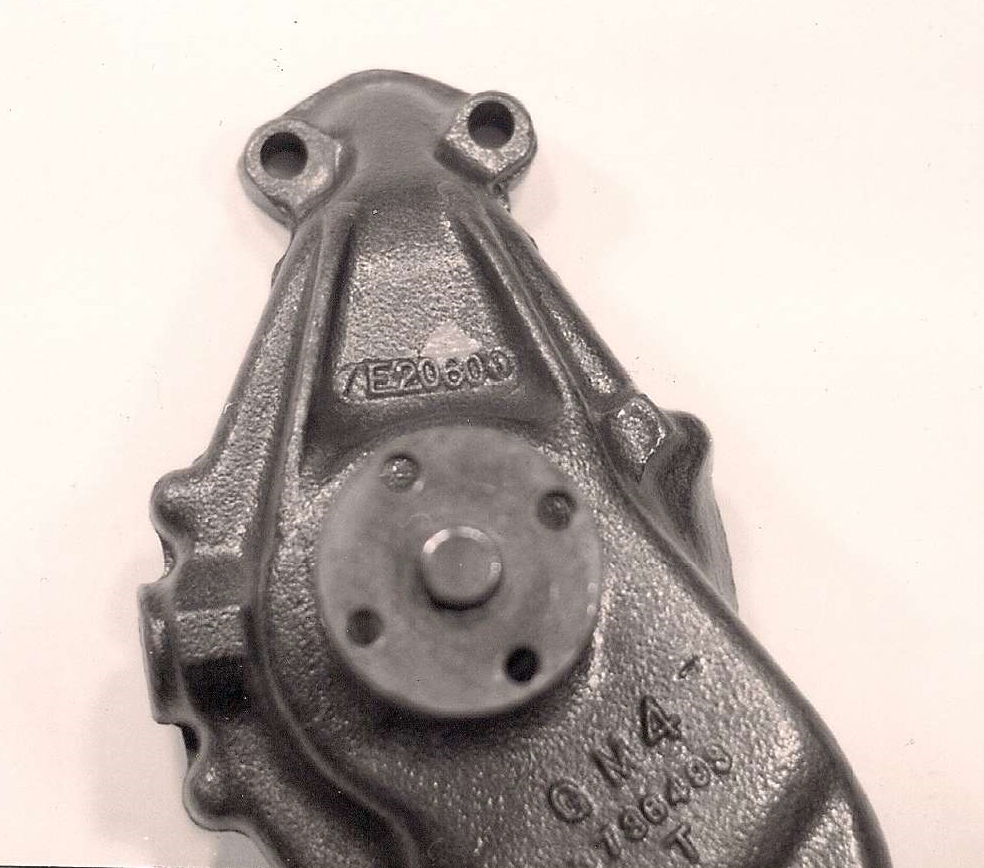
The first difference is that Tonawanda water pumps have external ribs or ridges, while Flint water pumps do not. Also, note that Tonawanda pumps have a cast “T” on them and that on Tonawanda water pumps the casting date is visible when the pump is installed on the engine. On Flint pumps, the casting date (if applicable) cannot be seen with the pump installed.
There are two basic styles of water pumps installed on these cars, the “short leg” pump and the “long leg” pump. Application of each style depends on model and year, but generally, the short leg was an earlier design and the long leg a later design. In the following text and casting number breakdowns, please realize that this is a very reliable, but probably not perfect, chapter. Because of the complexity of this chapter, each specific engine family is listed separately and the verified casting numbers are listed chronologically.

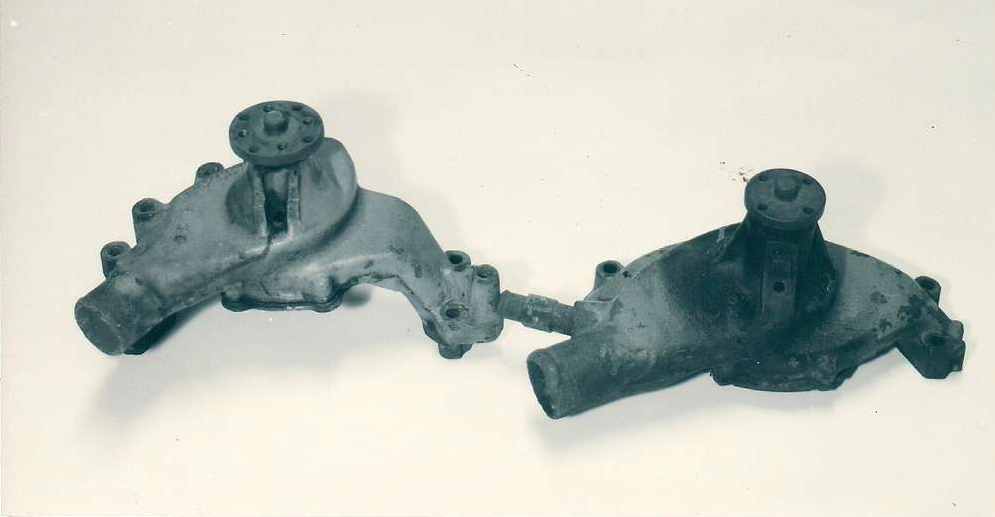
Many of the early water pumps covered in this book do not carry a casting date. Please refer to the specific features given and the chart below to identify the pump you are searching for. Where dating of water pumps is known, it is noted in the application table. (Truck water pumps have dates and can be identified by the two reinforcement webs on the pump.)
Where casting date codes are present, they follow the same pattern as engine blocks, but some do not carry the year. The month code is always a letter, followed by a number signifying the day. The last number signifies the year of production.W-block water pumps (as well as big-block pumps beginning in 1970) used a two-digit year code.
Water Pump Month Codes (1st Letter)
| A - January | E – May | I - September |
| B - February | F – June | J - October |
| C - March | G – July | K - November |
| D - April | H – August | L - December |
Example: Date code B 18 9 (Flint small block)
- B = Month: February
- 18 = Casting date: 18th
- 9 = Calendar Year: 1959 (refer to casting number charts to confirm)
Example: Date code B 18 59 (Tonawanda small block and Passenger Car W-block)
- B = Month: February
- 18 = Casting date: 18th
- 59 = Calendar Year: 1959
2. SMALL BLOCK WATER PUMPS
Small block Chevrolet engines used the “short leg” water pump on passenger cars through 1968 and on all Corvettes. Along with casting number changes through the years, there were also design changes due to the addition or deletion of accessory brackets. Note that a casting number of water pump overlap has not been verified.
Pump #3704911
| Year | Application | Engine | Horsepower |
| 1955* | Corvette | 265 | 195 |
| 1956** | Corvette | 265 | 210, 225, 240 |
| Note: The only difference between Tonawanda and Flint #3704911 pumps is the cast “T” on Tonawanda pumps. | |||
| *No 1955 pumps have a boss. **Has flat boss on top of pump. No dates |
|||
Pump #3736493
| Year | Application | Engine | Horsepower |
| 1957 | Corvette* | 283 | 220, 245, 250, 270, 283 |
| 1958 | Corvette* | 283 | 230, 245, 250, 270, 290 |
| 1959 | Corvette* | 283 | 230, 245, 250, 270, 290 |
| This was the first Tonawanda water pump that had “ribs”, and differed from Flint pumps in this way. Later pumps followed the same pattern. | |||
| *Uses special Corvette front engine mounting bracket. This pump was also used in 1960. No dates | |||
Pump #3736493
| Year | Application | Engine | Horsepower |
| 1960 (flat boss on pump top) | Corvette* | 283 | 230, 245, 250, 270, 290 |
| *Uses special Corvette front engine mounting bracket No dates |
|||
Pump #3782608
| Year | Application | Engine | Horsepower |
| 1963 | Corvette | 327 | 250, 300 |
| 1964 | Corvette | 327 | 250, 300 |
| *Service conversion only - Pump dates start March 1964 | |||
| 1965 | Corvette | 327 | 250, 300 |
| 1966 | Corvette | 327 | 300 |
| 1967 | Corvette | 327 | 300 |
| 1968 | Corvette | 327 | 300, 350 |
| 1969 | Corvette | 350 | 300, 350 |
| 1970 | Corvette | 350 | 300, 350 A/C, 350 w/o A/C, 370 |
Pump #3782609
| Year | Application | Engine | Horsepower |
| 1961 (bypass hole on top of pump) | Corvette* | 283 | 230, 245, 270, 275, 315 |
| 1962 | Corvette* | 327 | 250, 300, 340, 360 |
| 1963 | Corvette** | 327 | 340, 360 |
| *Uses special Corvette front engine mounting bracket **The changeover date to #3859326 casting number is still being researched. Flint Engine Plant build records show #3782609 in production in 1/4/63. No dates |
|||
Pump #3839175
|
Year |
Application |
Engine |
Horsepower |
|
1963(Late) (Small bypass hole on top of pump) |
Corvette |
327 |
340, 360 |
|
1964 |
Corvette |
327 |
365, 375 |
|
This water pump was used randomly in late 1963 and 1964 Corvette high performance engines. The reason for this is unknown and is still being researched. No dates |
|||
Pump #3859326
|
Year |
Application |
Engine |
Horsepower |
|
1963 (Small bypass hole on pump top) |
Corvette |
327 |
340, 360 |
|
1964 |
Corvette |
327 |
365, 375 |
|
Dates start November 1965 |
|||
Pump #3859326
|
Year |
Application |
Engine |
Horsepower |
|
1965 |
Corvette |
327 |
350, 365, 375 (Small bypass hole on top of pump) |
|
1966 |
Corvette |
327 |
350 |
|
1967 |
Corvette |
327 |
350 |
Date codes on the #3859326 water pump start in November 1965.
Pump #3927170
|
Year |
Application |
Engine |
Horsepower |
|
1969-71 |
All cars |
_ |
_ |
- In 1969, the water pump design changed from a “short leg” design to a “long leg” design, excluding the Corvette which changed in 1971.
- This water pump was used interchangeably with #3953692. #3953692 saw extensive usage. #3927170 saw very little usage.
Pump #3991399
|
Year |
Application |
Engine |
Horsepower |
|
1971 |
Corvette |
350 |
270, 330 |
|
1972 |
Corvette* |
350 |
200, 255 |
|
*The change-over date to the #330813 water pump is still being researched, although Flint engine plant build records show the #3991399 pump in production 11/3/71. The latest verified casting date for #3991399 is March 1972. The earliest verified casting date for #330813 is April 1972. This indicates that April could have been the change-over date between the two pumps. |
|||
Pump #330813
|
Year |
Application |
Engine |
Horsepower |
|
1972 |
Corvette* |
350 |
255 |
|
1973 |
Corvette |
350 |
190, 250 |
|
1974 |
Corvette |
350 |
195, 250 |
|
1975 |
Corvette |
350 |
165, 205 |
|
1976 |
Corvette |
350 |
180, 210 |
|
1977 |
Corvette |
350 |
180, 210 |
|
1978 |
Corvette |
350 |
175, 185, 220 |
|
1979 |
Corvette |
350 |
195, 225 |
|
1980 |
Corvette |
305 |
1805 |
|
|
|
350 |
190, 230 |
|
1981 |
Corvette |
350 |
190 |
|
1982 |
Corvette |
350 |
200 |
|
*See note at water pump #3991399 |
|||
3. Big Block Water Pumps
Big block Chevrolet engines used the “short leg” water pump on all Passenger cars from 1965 through 1968, and on the Corvette. Pumps used after these dates were the “long leg” design. Note that although the terminology used is the same as for small block water pumps, the actual water pumps do not interchange. All big block water pumps had a bypass provision on top of the pump.
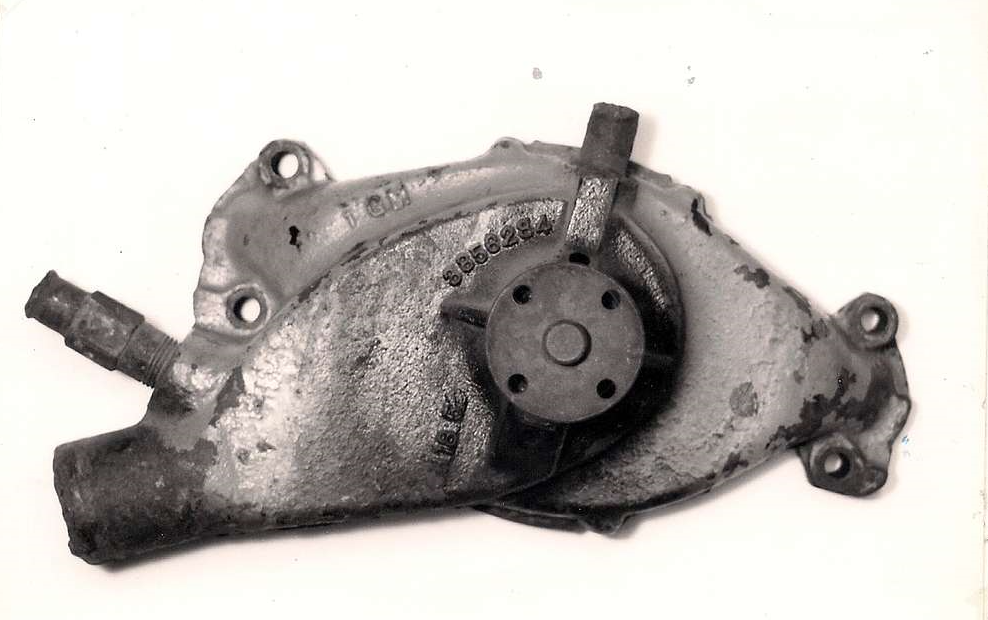

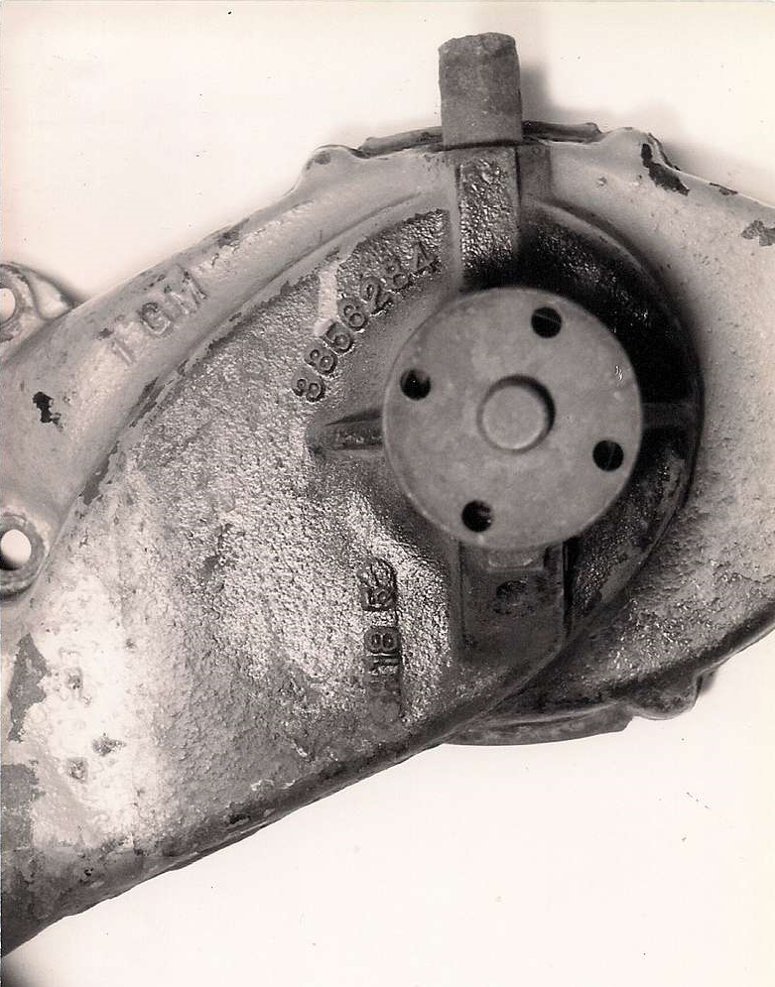
Pump #3856284
|
Year |
Application |
Engine |
Horsepower |
|
1965 |
Corvette |
396 |
425 |
|
1966 |
Corvette |
427 |
390, 400, 425, 450 |
|
1967 |
Corvette |
427 |
390, 400, 430, 435 |
|
1968 |
Corvette |
427 |
390, 400, 430, 435 |
|
1969 |
Corvette (early) |
427 |
390, 400, 430, 435 |
Pump #3940960
|
Year |
Application |
Engine |
Horsepower |
|
1969 |
Corvette* |
427 |
390, 400, 430, 435 Short leg |
|
1970 |
Corvette |
454 |
390 |
|
*Early production cars could have had the #3856284 or #3940960 water pump. This pump was installed in some 1970 models |
|||
Pump #3992077
|
Year |
Application |
Engine |
Horsepower |
|
1971 |
Corvette |
454 |
365, 425 Short leg |
|
1972 |
Corvette |
454 |
270 |
Pump #386100
|
Year |
Application |
Engine |
Horsepower |
|
1973 |
Corvette* |
454 |
245 Short leg |
|
1974 |
Corvette |
454 |
270 |
|
*Some early 1973 Corvettes have been verified using the #3992077 water pump |
|||
